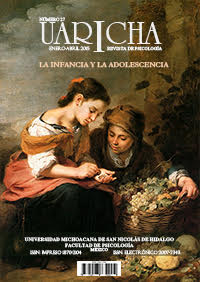Children´s theories of mind and semantic development among children from Bogota and Buenos Aires
Main Article Content
Abstract
The results of a study realized with a sample of 120 male and female children between 3 and 4 years old from the cities of Bogota- Colombia and Buenos Aires- Argentina are shown; the development of Children’s Theory
of mind and semantic development of language is compared in this study to identify cultural differences. For this study, three digitized versions of the task of the false belief were used by means of the Flash application, as well as the language subtest of the Scale of Wechsler WPPSI III, to evaluate the semantic abilities of the language. The findings indicate significant differences between the children’s ages in terms of their level of performance for each one of the tasks; positive associations between social understanding and semantic development of the language for two of the three proposed tasks were also found. In the same way, differences with respect to the nationality were evident.
Article Details
Section

This work is licensed under a Creative Commons Attribution-NonCommercial-NoDerivatives 4.0 International License.
The authors have the right to ownership or copyright and they give to "Uaricha Psychology Magazine" the right to publish for the first time the article, as well as disclose and distribute it on the technological available media and through repositories.
Uaricha Psychology Magazine, is a quarterly publication, published by the Psychology College of the "Universidad Michoacana de San Nicolás de Hidalgo", Street Francisco Villa No. 450, Col. Dr. Miguel Silva, Morelia, Michoacán, P. C. 58110. Phone (+52) 443 312 9909, ext. 149, www.revistauaricha.umich.mx, uaricha.publicaciones@umich.mx. Responsible publisher: Roberto Oropeza Tena. Reserve of exclusive use rights No. 04-2013-070413365500-203, e-ISSN: 2007-7343, Granted by the National Institute Copyright. Responsible of the last update of this number, Computer center of the Psychology College, Ing. Erick Vidar Alva Rangel.
How to Cite
References
Bermúdez-James, M. (2009a). Apego, comprensión y competencia social: medios digitales como forma de acceso al desarrollo social en la niñez. (Tesis inédita de maestría). Universidad de Los Andes, Bogotá
Bermúdez-James, M. (2009b). Teorías infantiles de la mente y el Lenguaje. ¿Un Problema de huevo o gallina? Revista iberoamericana de Psicología: Ciencia y Tecnología. 2, 67-85.
Callahan, T., et al., (2005). Synchrony in the onset of mental-state reasoning: Evidence from five cultures. Psychological Science, 16,5, 378-384
Dennett, D. (1978). The intentional stance. Cambridge. Mit Press.
Farhadian, M., Gazanizad, N & Shakerian, A. (2011). Theory of mind and Siblings among Preschool Children. Asian Social Science, 7, 3, 224- 231.
Flavell, J. H.; Speer, J., Green, F. & August, C. (1981). The development of comprehension monitoring and knowledge about communication. Monographs of the Society for Research in Child Development, 5, 46, 1- 65.
Flavell, J.H., Flavell, E.R. & Green, F.L. (1983). Development of the appearance – reality 16. Guitart, M (2009). Hacia una psicología cultural. Origen, desarrollo y perspectivas.Fundamentos en Humanidades. 11, 7-23.
Hernández, R., Fernández, C. y Bautista, P. (1998) Metodología de la InvestigaciónMéxico: MacGraw-Hill.
Lecannelier, F. (2004). Los Aportes de la Teoría de la Mente (TOM) a la Psicología del Desarrollo. Terapia Psicológica.22 (01), 61-67.
Lu, H. & Wang, Q. (2008). Talking about others facilities theory of mind in chinese preschoolers. Developmental Psychology. 44 (6), 1726-1736.
Markus, H. & Hamedani, M. (2007). Sociocultural Psychology: The Dynamic Interdependence among Self Systems and Social Systems. En Sh. Kitayama y D. Cohen (Eds.), Handbook of Cultural Psychology (pp. 3-39). New York y London: The Guilford Press.
Mishra, R., Dasen, P., & Nirula, S. (2003). Ecology, languaje, and performance on spatial cognitive task. International Journal of Psychology, 38, 6, 366-383.
Piaget, J. (1985). Seis estudios de Psicología. Barcelona: Planeta de Agostini.32. Perner, J. (1991). Comprender la Mente Representacional. Paidos. Madrid.
Peterson, C. (2001). Influence of siblings‟ perspectives on theory of mind. Cognitive Development, 15, 435-455. Doi: no presenta
Premack, D. & Woodruff, G. (1978). Does the chimpanzee have a theory of mind? Behavioral and Brain Science. 1, 515- 516. Doi 10.1371
Puyuelo, M., Rondal, J., y Wiig, E. (2005): Evaluación del lenguaje. Barcelona: Masson.
Rabazo, M., y Moreno, J. (2007). Teoria de la Mente: la construcción de la mente mediante los cuentos de hadas. Enseñanza e investigaciones, 12(01), 179-201
Resches, M., Serrat, E., Rostam, C., y Esteban, M. (2010). Language and Theory of Mind: A multidimensional approach. Infancia y Aprendizaje, 33(3), 315-333. 10.1174/021037010792215136
Riquelme, E., Henriquez, C., y Álvarez, B. (2003). Relación entre estilos de apego y teoría de la mente. Psykhe, 12(1) 73-81.
Serra, M., Serrat, E., Solé, R., Bel, A., y Aparici, M. (2000). La adquisición del lenguaje. Barcelona. Ariel.
Wellman, H. M., y Liu, D. (2004). Scaling of Theory of Mind tasks. Child Development, 75(2), 523-541.

